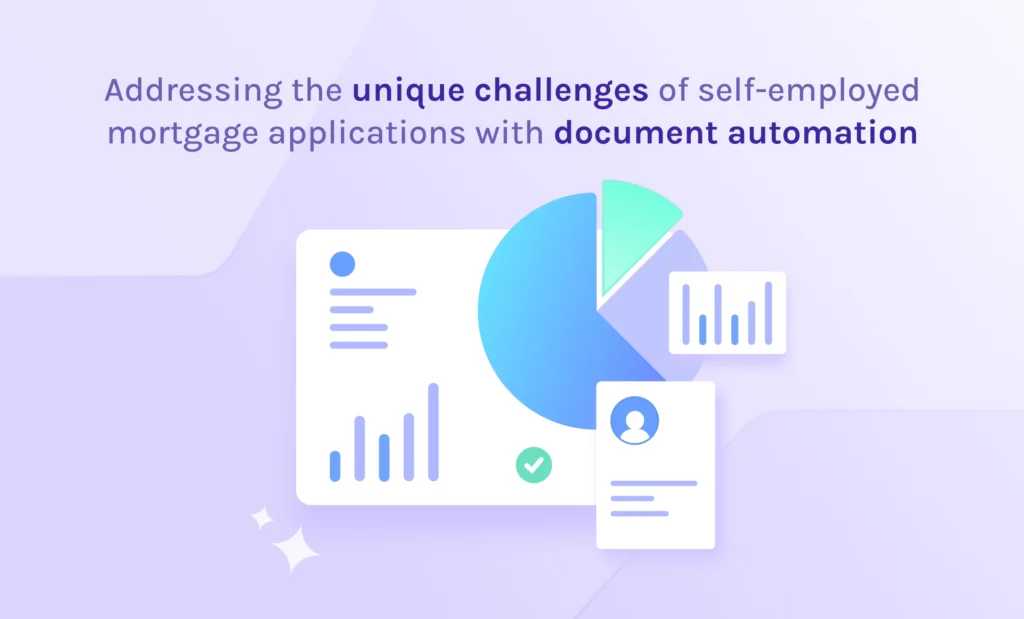Addressing the unique challenges of self-employed mortgage applications with document automation

Profiles of self-employed borrowers challenge lenders to look beyond traditional underwriting processes to assess creditworthiness.
Traditional review methods often fail to capture the comprehensive financial picture of these borrowers, necessitating a more sophisticated approach. In addition, the diverse and extensive documentation required makes manually reviewing and analyzing complex income profiles a time-consuming and error-prone task.
AI-powered document automation can help lenders simplify the income calculation and verification process. This technology gives lenders a more accurate understanding of self-employed borrowers’ financial situations, improving the overall decision-making process.
Challenges of self-employed mortgage applications
As Millennials and Gen-Z enter the housing market, lenders are encountering a growing number of self-employed individuals and gig workers seeking mortgages. This demographic shift requires a move away from traditional credit evaluation methods. For a complete view of these individuals’ financial health, lenders often need to consider a broader range of financial documents, including bank statements and pay stubs, to demonstrate their income.
Conventional credit metrics, such as credit scores, often need more indicators of creditworthiness for nontraditionally employed borrowers. Lenders must dive deeper into financial data to correctly assess the financial stability of self-employed applicants.
Manually calculating income based on this information is labor-intensive and prone to errors, potentially leading to inaccurate evaluations and misguided lending decisions. Cash flow automation solutions enable lenders to streamline income and cash flow analysis. These tools enhance accuracy, reduce processing times and boost overall decision-making quality, creating a better experience for lenders and borrowers.

Cash flow automation for mortgage lending
Initially designed for small business lending, cash flow automation tools are now widely used across different lending sectors, including mortgage lending. These tools monitor the inflow and outflow of funds in a borrower’s account in real time, offering a dynamic view of their financial health for lenders who need to make sound decisions.
Cash flow automation tools provide a comprehensive picture of financial stability by examining an applicant’s income, expenses, transactions and financial trends. This real-time analysis is crucial for understanding the financial behaviors and risks of self-employed borrowers.
For lenders, cash flow analysis is vital in credit risk modeling. Automation and machine learning create detailed profiles of loan applicants, enabling more accurate analysis based on standardized data. These tools can also help identify patterns that may not be visible through manual analysis, offering more profound insights into an applicant’s financial health.
Comprehensive non-traditional income calculation
Integrating cash flow data into the evaluation process gives lenders a detailed view of financial stability that surpasses traditional evaluation methods. This approach offers a more precise tool for risk assessment than credit history alone, and has the potential to expand access to financing for potential homebuyers.
For example, gig economy workers might have robust financial profiles but don’t meet the requirements for a qualified mortgage (QM). Cash flow analysis helps non-QM lenders evaluate a customer’s financial situation thoroughly, creating fairer and more informed lending decisions. By incorporating real-time data, lenders can also anticipate future financial trends for more reliable long-term insights.
How document automation goes beyond traditional methods
AI-driven document automation revolutionizes the income calculation and verification process by quickly extracting essential data and performing complex calculations. Streamlining verification enables lenders to efficiently manage a wide spectrum of income data efficiently, enhancing both speed and accuracy.
With robust, inclusive and adaptable income verification processes, lenders can accommodate a broader range of financial profiles by making the lending process more equitable and thorough, improving overall customer satisfaction and operational efficiency. This adaptability ensures that, while financial landscapes evolve, lenders remain equipped to provide accurate and fair assessments.
Book a demo to learn how Ocrolus can help you confidently assess complex borrower profiles with AI-powered document automation.
Key takeaways:
- Manual income calculation for self-employed mortgage applicants is time-consuming and error-prone, often missing critical financial details.
- AI-powered document automation quickly captures, validates and analyzes data from various documents, reducing the need for tedious manual review.
- Automated cash flow analysis provides a more complete view of financial stability, enabling mortgage lenders to make informed, accurate decisions based on reliable information.


